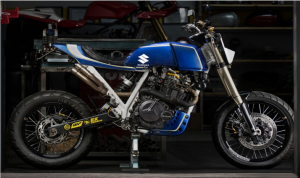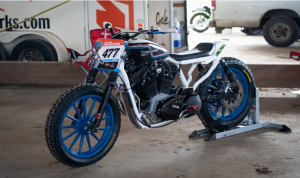Tracker: What makes the remake so different from the original?
1910 marks the beginning of Trackers rooting from the fierce sport of Board Track racing. Gradually increasing in popularity before the arrival of the Great Depression it was conducted on a gigantic ovular race track, where the riders are drifting and sliding swiftly through turns. Initially, motorcycles were used only to tow cyclists onto the course, but, with the advancements of machinery, the bikes ultimately replaced these cycles.
The motorcycles used for these races were called Trackers or more specifically flat trackers- as the tracks were flat, having no obstacles other than the racers. Since the 50’s manufacturers such as Harley-Davidson, Honda, Triumph, Indian, and Kawasaki have been producing flat trackers.
Made for the sole purpose of track racing on the dirt oval race circuits, they have a few key features which we delve into:
● Slender seat – to balance your body weight across pegs and reposition it up and down according to turns and speed.
- Situated at the back of the seat is the duct tape. This part helps in streamlining the bikes’ profile, shielding riders of kicked-up soil and residue. Fundamental for maintaining tracker’s profile.
- Wide and high handlebars – for better control and cornering influence
- Flat tires – gives ideal footing on the level track’s hard stuffed surface. It’s a standard to check flat track motorbikes, particularly current, with approximately 19-inch back and front edges, however, you’ll discover a ton likewise running approximately 18 front and back.
- Exhaust – situated on the rider’s right side giving him/her additional space to breathe while hitting the circuit that is counter-clockwise. With a somewhat calculated suppressor, however, there is unquestionably not a standard look. Exhausts sometimes are placed up high, down low, it depends upon the individual’s inclination and bike plan.
- Small Petrol Tanks: Smaller tanks lead to less volume of petroleum, therefore, lesser weight
During the 1980s the focus shifted from flat tracking to road racing. Due to this, the sport’s popularity began to decline. Although the ovular track gradually lost its spotlight, Trackers remain notorious for their rich history and visual style.
They may have changed fundamentally, over the years, yet the essence of the bike hasn’t faded instead it has been transformed into a street tracker.
A street tracker is a model of a flat tracker motorbike, replicating its functioning and design. Yet, street trackers are not confined to flat trackers. Street trackers are an interesting concept to build a motorcycle, there are unlimited possibilities, as you can build them out of anything. Though there are a couple of parameters that one must stay within:
- A flat line must be maintained from a gas tank through the seat
- One or two-cylinder engine- rich in torque to enable you to break free the rear tire.
- The 19-inch wheel which you can also see in flat tracks, though the 18-inch rear is mostly seen for the versatility of the street-legal rubbers available.
Other features that reflect the derived inspiration from flat trackers are an upgraded suspension, bendable and adjustable levers, and brakes. Moreover, the design usually includes a tall tail section with a long single seat that curves up towards the rear.
In contrast, some of the features that street trackers had to adapt since they are not made for racing was firstly to have headlights or blinkers and a license plate, as they are a mandatory requirement for street legality.
The popularity of street trackers in the world of cafe racers was coincidental with the gaining popularity of Super Hooligan racing, making it an acclaimed platform for the styles of customization based on the bikes chosen for the series.
You will see Indian Scout trackers, sometimes a Ducati Scrambler or Star Bolt, and the most well-known choice by a long shot for tracker transformation—the Harley-Davidson Sportster.
Following are some of the coolest custom-built, Street trackers of 2020, having not just the looks but an efficient functionality too. These examples will give you an insight into how Street trackers are customized.
#1 Suzuki DR800
Frateschi Garage of Brazil upgraded a 1996 Suzuki DR800 to a street tracker. To give it the solo seat and tracker-style tail, it had its subframe modified. Moreover, got Sach’s adjustable rear shocks, Brembo brakes, stainless exhaust, and 19 to 17 inches wheels. Some of the features that make DR800 stand out are its app displaying rpm, velocity, fuel consumption, and GPS.
#2 “Lucky Me”
Robot Motorwork’s founder, Muhammad Robbi built a Dyna street tracker, intending to make a street tracker with enhanced road comfortability and light off-roading. Harley-Davidson 103-inch Twin’s engine was rebuilt, to add to it, custom-made parts like a stainless exhaust, one-off swingarm, and 1.6mm headlight built from a steel plate.
#3 Beta 200
During a competition Argentinian Builder’s Challenge, 7 days were given to 4 teams for customizing Beta Motard 250 or 200 into either a scrambler or tracker. One of the teams modified the sub-frame by making a number plate (3D-printed) for headlights, altered the gas tank, new seat, and painted the bike.
#4 Hooligan
Hooligan was 883 Sportster back in 2001, consisting of 19-inch rubber wheels (flat-track), 1200cc engine, and motocross-style bars. Tony, Hooligan’s rider, decided to upgrade it in 2020. Therefore, he built such an oil tank that could easily fit in front of the motor hence the bike’s center of gravity was moved, improving its balance. To add to it, 1275cc cylinders and pistons were added, making this one of the most eloquent hooligan trackers.
#5 Yamaha XT250 ‘DragonFly’
Yamaha XT250 of 1983, a long-forgotten motorbike, its disassembled parts abandoned in a garage. Nicknamed Dragon Fly because of its skinny structure and wide bars dangling on the sides. He replaced the handlebars with a Yamaha AG100, white powder-coated having black bark busters. Moreover, he installed an electronic ignition (12-volt), ported and decked head, and an oversized piston in the rebuilt engine. Francesco was successful in upgrading the bike to the best of his abilities.


